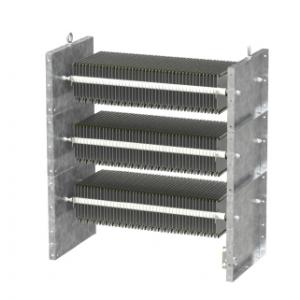Railway resistors
LINE TEST RESISTORS
Line test resistors for railway applications are used to detect fault conditions on overhead lines (catenaries) before switching on the power. The line-test resistor is switched to the line and if no fault current is detected it is deemed safe to close the HSCB (High-Speed Circuit-Breaker) as HSCB lifetime is inversely proportional to the number of fault clearances. Indeed, it may be required that such a test (with fault conditions) be repeated several times in a row and these resistors can help to locate the faults when several short line-test are applied.
TRAIN BRAKING RESISTORS
Braking a train is always done by electric resistors. Mechanical brakes wear out too quickly and require expensive maintenance. During braking, the kinetic energy of the train is transformed into electric energy and if possible, fed back to overhead line but this can only be done if another train is connected to the same overhead line and can use the energy. If this is not possible, then the energy must be dissipated as heat in onboard resistors. There are three possible locations for brake resistors:
- On the roof of the train where the hot air is released upwards.
- On the chassis of the train where the hot air is released to the side.
- Inside the vehicle in special compartments.
All locations may use natural convection or forced-air cooling.
